Is a Blown Transformer Dangerous? What You Need to Know About Safety Risks?
Have you ever heard a loud bang followed by a power outage in your neighborhood? Chances are, you’ve experienced a blown transformer. But how dangerous is this situation, and what should you do if you encounter one?
A blown transformer can be extremely dangerous, posing risks of fire, electrocution, and environmental hazards. It can cause power outages, release toxic substances, and create electrical hazards in the surrounding area. Understanding the risks and knowing how to respond is crucial for public safety.
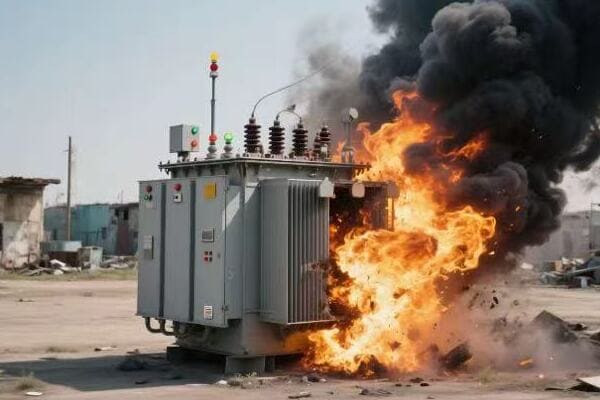
In this article, I’ll explain the safety risks associated with blown transformers, what happens to your power supply, and how to identify and respond to these incidents. Whether you’re a homeowner or a professional in the field, this information could be crucial for your safety and those around you.
Can a Blown Transformer Cause Fire or Electrocution?
Have you ever wondered about the real dangers when a transformer blows? The risks are more serious than you might think. But what exactly are the fire and electrocution hazards associated with a blown transformer?
A blown transformer can indeed cause fires and pose electrocution risks. The intense heat and electrical arcing can ignite surrounding materials, while exposed wires and energized components create electrocution hazards. Oil-filled transformers can also leak flammable oil, further increasing the fire risk.
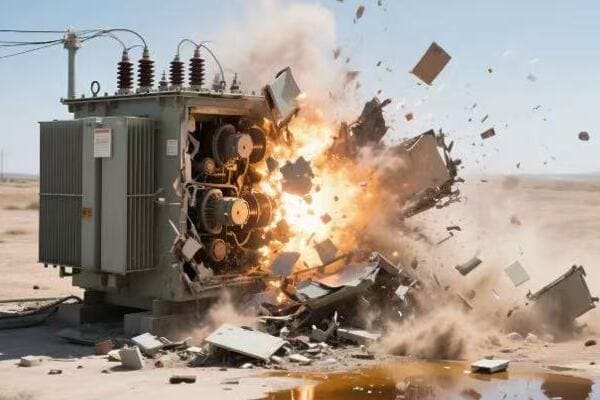
Understanding the Fire and Electrocution Risks
Let’s break down the specific dangers associated with blown transformers:
1. Fire Hazards
Blown transformers can cause fires due to:
- Electrical arcing igniting nearby materials
- Overheating of internal components
- Leakage of flammable transformer oil
I once witnessed a transformer explosion that started a small brush fire. The intense heat and sparks ignited dry vegetation nearby, highlighting the importance of clear areas around transformers.
2. Electrocution Risks
The electrocution dangers include:
- Exposed live wires from damaged equipment
- Energized debris scattered during the explosion
- Ground faults creating electrical hazards in the area
3. Oil Spill Hazards
For oil-filled transformers:
- Hot oil can spray out during a failure
- Oil spills can create slipping hazards
- Some older transformers contain harmful PCBs
4. Environmental Impact
Beyond immediate safety risks:
- Oil spills can contaminate soil and water
- Smoke from fires may contain toxic substances
- Cleanup can be complex and environmentally sensitive
Here’s a table summarizing the risks and their potential impacts:
| Risk Type | Immediate Danger | Potential Long-term Impact |
|---|---|---|
| Fire | Burns, property damage | Environmental contamination |
| Electrocution | Severe injury or death | Electrical system damage |
| Oil Spill | Burns, slipping hazards | Soil and water pollution |
| Toxic Smoke | Respiratory issues | Air quality degradation |
In my years of experience, I’ve seen the devastating effects of transformer fires firsthand. One particularly memorable incident involved a large substation transformer that exploded due to a lightning strike. The resulting fire was intense, fueled by thousands of gallons of transformer oil. It took firefighters hours to contain, and the environmental cleanup lasted for weeks.
The electrocution risk from blown transformers is often underestimated. I recall a case where a curious bystander approached a damaged transformer after a storm, not realizing that the ground around it was energized. Fortunately, a quick-thinking neighbor stopped them before they got too close. This incident led to a community education program on electrical safety that I helped develop.
One fascinating aspect of transformer failures is how they can create unexpected electrical hazards. In a recent case, a blown transformer caused a phenomenon known as "step potential" in the surrounding area. This created voltage gradients in the ground that could have caused electrocution to anyone walking nearby. We had to use specialized equipment to safely assess and neutralize this invisible threat.
The environmental impact of transformer failures, especially those involving oil spills, can be significant and long-lasting. I once worked on a remediation project where a transformer explosion had contaminated soil and groundwater with PCBs. The cleanup process was complex, involving soil excavation, groundwater treatment, and long-term monitoring. This experience highlighted the importance of proper transformer maintenance and the use of environmentally friendly transformer oils.
Fire suppression systems for transformers have come a long way. In a recent project, I helped design a state-of-the-art fire detection and suppression system for a critical substation. This system used a combination of heat sensors, arc detection, and fast-acting suppression agents to minimize the risk of fire spread. While such systems are expensive, they can prevent catastrophic losses and enhance overall grid reliability.
The risk of toxic smoke from transformer fires is an often-overlooked hazard. Many transformers contain materials that can produce harmful fumes when burned. In a recent incident response training I conducted, we emphasized the importance of proper protective equipment for first responders and the need for community evacuation plans in case of large transformer fires.
Lastly, the psychological impact of witnessing a transformer explosion shouldn’t be underestimated. I’ve been involved in post-incident counseling sessions where people described the trauma of seeing and hearing a large transformer fail. The loud bang, bright flash, and subsequent power loss can be genuinely frightening, especially for those unfamiliar with electrical systems.
Understanding the fire and electrocution risks associated with blown transformers is crucial for public safety. While these incidents are relatively rare, their potential for harm makes it essential for both professionals and the public to be aware of the dangers and proper response procedures. As we continue to rely heavily on our electrical infrastructure, ongoing education and improved safety measures will be key to minimizing these risks.
What Happens to the Power Supply After a Blowout?
Have you ever experienced a sudden blackout and wondered what’s going on behind the scenes? When a transformer blows, it’s not just a momentary glitch – it can have far-reaching effects on the power supply. But what exactly happens to your electricity when a transformer fails?
When a transformer blows, it typically causes an immediate power outage in the area it serves. The extent of the outage depends on the transformer’s location and role in the power grid. While some areas may experience brief interruptions, others might face prolonged blackouts until repairs or replacements are completed.
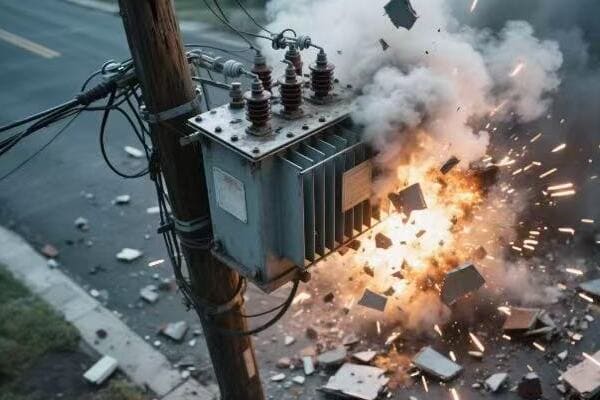
Understanding the Impact on Power Supply
Let’s explore what happens to the power supply after a transformer blowout:
1. Immediate Power Loss
The first and most obvious effect:
- Sudden blackout in the affected area
- Safety systems isolate the damaged section
- Extent depends on the transformer’s role in the network
I once managed a response to a major transformer failure at a substation. The initial blackout affected several neighborhoods, but quick action by our team limited the long-term impact to a smaller area.
2. Rerouting of Power
Efforts to restore power:
- Grid operators attempt to reroute electricity
- Some areas may regain power quickly
- Others might remain dark due to network limitations
3. Load Shedding
Managing the grid’s stability:
- Controlled outages in some areas
- Prevents cascading failures across the grid
- Prioritizes critical infrastructure
4. Repair and Restoration Process
Steps to bring power back:
- Assessment of damage
- Repair or replacement of the transformer
- Gradual restoration of power to affected areas
Here’s a table showing typical timelines for power restoration:
| Scenario | Estimated Restoration Time | Factors Affecting Duration |
|---|---|---|
| Minor Transformer Failure | 2-4 hours | Availability of spare parts |
| Major Substation Transformer Failure | 24-72 hours | Complexity of repairs, size of affected area |
| Catastrophic Failure Requiring Replacement | 1-7 days | Availability of replacement transformer, installation time |
In my experience, the impact of a transformer blowout can vary dramatically depending on the specific circumstances. I recall a case where a small distribution transformer failed in a residential area. While the immediate neighborhood lost power, we were able to reroute electricity from adjacent circuits and restore service to most homes within a few hours.
However, I’ve also dealt with more severe cases. One particularly challenging incident involved the failure of a large substation transformer during a heatwave. The sudden loss of this critical piece of infrastructure put immense strain on the remaining grid. We had to implement rolling blackouts across a wide area to prevent a cascading failure that could have blacked out the entire city.
The concept of load shedding is crucial in managing these situations. I’ve been involved in developing automated load shedding systems that can quickly respond to sudden losses in grid capacity. These systems prioritize critical infrastructure like hospitals and emergency services while temporarily cutting power to less essential areas. It’s a delicate balance between maintaining overall grid stability and minimizing disruption to consumers.
One fascinating aspect of power restoration after a transformer failure is the sequence in which different areas regain electricity. I’ve worked on creating restoration protocols that consider factors like population density, presence of critical facilities, and the technical constraints of the power system. This often means that some neighborhoods may see their lights come back on while adjacent areas remain dark, leading to understandable frustration among residents.
The challenge of replacing large transformers cannot be overstated. These are not off-the-shelf components; they’re often custom-built and can take months to manufacture. I’ve been involved in projects to create strategic reserves of spare transformers, positioned at key locations around the country. This foresight can dramatically reduce restoration times in the event of a catastrophic failure.
Smart grid technologies are revolutionizing how we respond to transformer failures. In a recent project, I helped implement a self-healing grid system that could automatically detect faults, isolate the affected area, and reroute power without human intervention. This technology can reduce outage times from hours to minutes in many cases.
Lastly, the impact of transformer failures on power quality is an often-overlooked issue. Even after power is restored, voltage fluctuations and harmonics introduced by the disruption can affect sensitive electronic equipment. I’ve worked with industrial clients to implement power conditioning systems that can protect their operations from these secondary effects of grid disturbances.
Understanding what happens to the power supply after a transformer blowout is crucial for both utility operators and consumers. While these events can cause significant disruption, advances in grid technology and management strategies are continually improving our ability to respond quickly and effectively. As our reliance on electricity grows, so too does the importance of a resilient and responsive power grid.
Visual and Audible Signs of a Blown Transformer?
Have you ever heard a loud bang or seen a bright flash in your neighborhood, followed by a power outage? These could be signs of a blown transformer. But what exactly should you look and listen for to identify this potentially dangerous situation?
A blown transformer often produces distinctive visual and audible signs. These can include a loud boom or bang, a bright flash or fireball, smoke or fire, and a sudden loss of power. You might also hear buzzing or hissing sounds, smell burning odors, or see oil leaking from the transformer.
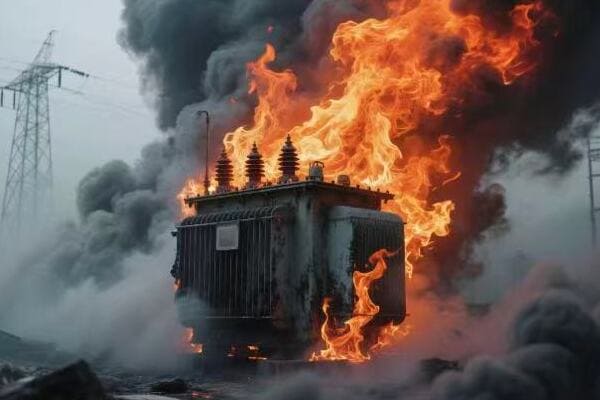
Recognizing the Signs of a Blown Transformer
Let’s explore the key indicators that a transformer has blown:
1. Audible Signs
What you might hear:
- A loud bang or explosion sound
- Buzzing or hissing noises
- Crackling sounds from electrical arcing
I once responded to a call where residents reported hearing what they thought was a gunshot. It turned out to be a transformer exploding, highlighting how startling and distinctive this sound can be.
2. Visual Signs
What you might see:
- A bright flash or fireball
- Smoke or flames
- Sparks or electrical arcing
- Oil leaking from the transformer
3. Power-Related Signs
Effects on electricity:
- Sudden power outage in the area
- Flickering lights before the outage
- Partial power loss or dimming
4. Other Sensory Signs
Additional indicators:
- Burning odor or smell of ozone
- Ground vibrations near the transformer
- Warm pavement around pad-mounted transformers
Here’s a table summarizing the signs and their implications:
| Sign | What It Indicates | Severity Level |
|---|---|---|
| Loud Bang | Sudden internal failure | High – Immediate attention needed |
| Bright Flash | Electrical arcing or explosion | High – Potential fire hazard |
| Smoke/Fire | Active burning of components | Critical – Fire risk |
| Oil Leakage | Rupture of transformer casing | Moderate to High – Environmental hazard |
| Buzzing/Hissing | Internal electrical issues | Low to Moderate – May precede failure |
In my years of experience, I’ve learned that recognizing these signs quickly can be crucial for public safety. I remember a case where alert neighbors reported hearing a strange buzzing sound from a transformer. When our team investigated, we found the transformer on the verge of failure. Their prompt reporting allowed us to replace it before a potentially dangerous blowout occurred.
The visual signs of a transformer failure can be quite dramatic. In one incident I responded to, witnesses described seeing a "blue fireball" accompanied by a shower of sparks. This spectacular display was caused by the ionization of air around the transformer as it failed catastrophically. While visually impressive, such events pose serious safety risks to anyone nearby.
One often overlooked sign of impending transformer failure is the smell. I’ve trained many field technicians to recognize the distinct odor of overheating electrical equipment or burning oil. In a recent case, a subtle burning smell led us to discover a transformer that was overheating due to an internal fault, allowing us to address the issue before it escalated to a full blowout.
The sound of a transformer explosion can be mistaken for other events. I once conducted a community awareness program after a series of transformer failures were mistaken for gunshots, causing unnecessary panic. We educated residents on the distinctive characteristics of transformer explosions – typically a single, very loud bang rather than multiple shots.
Interestingly, animals can sometimes sense impending transformer failures before humans notice anything amiss. In a rural substation project, we observed that local wildlife would avoid the area around a transformer that was developing issues, long before our instruments detected any problems. This led to discussions about incorporating animal behavior monitoring into our predictive maintenance strategies.
Weather conditions can affect how noticeable transformer failure signs are. During a severe thunderstorm, I was part of a team responding to multiple transformer failures. The challenge was distinguishing transformer explosions from thunder, and electrical flashes from lightning. We had to rely more heavily on power outage reports and our monitoring systems to locate the actual failures.
Lastly, the importance of public education about these signs cannot be overstated. I’ve been involved in developing community outreach programs that teach residents how to recognize and report signs of transformer issues. This grassroots approach to early detection has proven invaluable in preventing potential disasters and improving overall grid reliability.
Recognizing the visual and audible signs of a blown transformer is crucial for both safety and prompt response. While some signs like loud bangs and bright flashes are obvious, others like subtle odors or unusual sounds require more awareness. By understanding these indicators, both professionals and the public can play a role in quickly identifying and responding to potentially dangerous transformer failures.
What You Should Do If You See One?
Have you ever wondered what to do if you encounter a blown transformer? It’s a scenario that can be both frightening and dangerous. But how should you react to ensure your safety and that of others around you?
If you see a blown transformer, prioritize safety above all. Stay at least 30 feet away, call emergency services immediately, and never attempt to approach or touch the transformer or any fallen wires. Keep others away from the area, and wait for professional help to arrive. Do not attempt to extinguish any fires yourself.
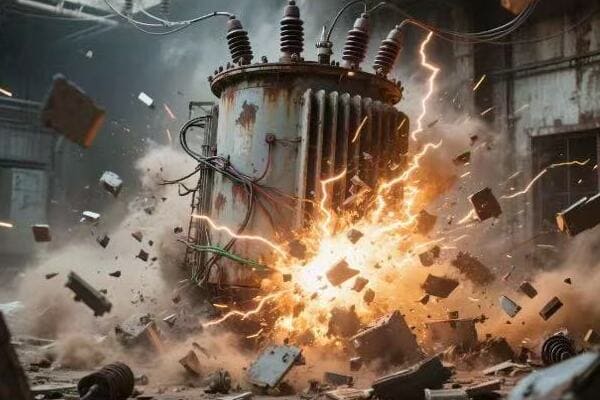
Steps to Take When Encountering a Blown Transformer
Let’s go through the essential actions you should take:
1. Maintain a Safe Distance
Your first priority:
- Stay at least 30 feet away from the transformer
- Keep others, including pets, away from the area
- Be aware that the ground around the transformer may be energized
I once witnessed a bystander approach a fallen transformer to "see if they could help." It was a heart-stopping moment, and I had to shout to stop them. This experience reinforced the critical importance of maintaining a safe distance.
2. Call for Professional Help
Who to contact:
- Dial emergency services (911 in the US)
- Contact your local utility company
- Provide clear information about your location and the situation
3. Avoid Physical Contact
Crucial safety measures:
- Do not touch the transformer or any fallen wires
- Stay away from trees or objects in contact with power lines
- If in a vehicle near fallen wires, stay inside until help arrives
4. Be Aware of Your Surroundings
Additional precautions:
- Look out for signs of fire or smoke
- Listen for unusual sounds like hissing or buzzing
- Be prepared for potential power outages in the area
Here’s a quick reference table for actions to take:
| Situation | Action | Reason |
|---|---|---|
| Transformer on Fire | Call 911, evacuate area | Fire can spread quickly |
| Fallen Power Lines | Stay far away, call utility | Risk of electrocution |
| Oil Leakage | Report to utility, avoid contact | Environmental hazard |
| Loud Noises/Flashes | Move away, report immediately | Indicates active failure |
| Power Outage | Report to utility, use caution | May be widespread issue |
In my years of experience dealing with transformer incidents, I’ve learned that public response is crucial in preventing further danger. I recall a situation where a transformer blew in a residential area during a storm. A quick-thinking neighbor immediately called the utility company and used his car to block the street, preventing others from approaching the hazardous area. His actions potentially saved lives that day.
One aspect often overlooked is the potential for secondary hazards. In a memorable incident, a blown transformer caused a small fire that quickly spread to nearby dry vegetation. I was part of the response team, and we had to coordinate with both the utility company and the fire department. This experience highlighted the importance of being aware of your surroundings and considering all potential risks, not just the immediate electrical hazard.
The psychological impact of witnessing a transformer explosion shouldn’t be underestimated. I’ve been involved in community debriefings after such incidents, and many people describe feeling shocked and disoriented. It’s important to remember that your own mental state can affect your decision-making in these situations. Stay calm, focus on safety, and don’t hesitate to seek support if you feel overwhelmed.
One fascinating aspect of transformer failures is how they can create unexpected electrical hazards in the surrounding area. I once used specialized equipment to detect ground voltage gradients around a failed transformer. We found that the ground up to 50 feet away was electrically charged, far beyond what most people would expect. This reinforced the importance of maintaining a generous safety perimeter.
In urban environments, the challenge of keeping people away from a blown transformer can be significant. During a recent incident in a busy downtown area, we had to quickly establish a safety cordon. I worked with local law enforcement to set up barriers and redirect pedestrian traffic. This experience showed me the importance of quick, coordinated action between utility workers and emergency services.
The rise of social media has introduced new considerations in responding to transformer incidents. I’ve been involved in developing protocols for utility companies to quickly disseminate safety information through social platforms during such events. This can be a powerful tool for keeping the public informed and safe, but it also requires careful management to prevent the spread of misinformation.
Lastly, I can’t stress enough the importance of not attempting amateur repairs or investigations. In one alarming case, I arrived at a scene to find a well-meaning individual attempting to "fix" a damaged transformer with household tools. This extremely dangerous behavior could have resulted in severe injury or death. Always leave any interaction with damaged electrical equipment to trained professionals.
Knowing what to do when you encounter a blown transformer is crucial for public safety. The key points to remember are: maintain a safe distance, call for professional help immediately, avoid any physical contact with the transformer or fallen wires, and be aware of your surroundings. By following these guidelines, you can help ensure your safety and that of others around you during these potentially dangerous situations.
Who to Call and When?
Have you ever found yourself unsure about who to contact in an electrical emergency? When faced with a blown transformer, knowing who to call and when can make a crucial difference in safety and response time. But how do you navigate the various agencies and services available?
In case of a blown transformer, immediately call emergency services (911 in the US) if there’s any immediate danger like fire or injuries. Then, contact your local utility company to report the outage and transformer issue. For non-emergency situations, use the utility’s dedicated line for reporting power issues.
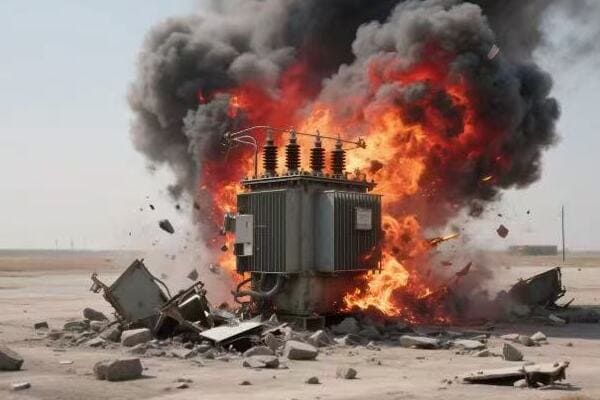
Understanding Who to Contact in Transformer Emergencies
Let’s break down the key contacts and when to reach out to them:
1. Emergency Services (911)
When to call:
- Immediate danger to life or property
- Fire or explosion
- Injuries or potential for injuries
- Transformer oil spilling into waterways
I once responded to a scene where a resident had wisely called 911 first when they saw flames engulfing a transformer. This quick action allowed firefighters to contain the blaze before it spread to nearby structures.
2. Local Utility Company
When to contact:
- To report the blown transformer
- For power outages related to the transformer
- Sparking or arcing from the transformer
- Oil leaks without immediate danger
3. Non-Emergency Police Line
When it’s appropriate:
- Traffic control needed around the affected area
- Crowd management in public spaces
- Suspicious activity near electrical infrastructure
4. Local Government Office
For follow-up:
- Questions about prolonged outages
- Community impact concerns
- Information on restoration efforts
Here’s a quick reference table for who to call in different situations:
| Situation | Who to Call | Priority |
|---|---|---|
| Fire or Explosion | 911 | Immediate |
| Injuries | 911 | Immediate |
| Power Outage | Utility Company | High |
| Oil Leak (no immediate danger) | Utility Company | High |
| Sparking/Arcing | Utility Company | High |
| Traffic Issues | Non-Emergency Police | Moderate |
| General Inquiries | Local Government | Low |
In my experience, the sequence of calls can be just as important as knowing who to call. I recall an incident where a transformer blew in a busy urban area. The first call to 911 brought emergency services to secure the area. Immediately after, we contacted the utility company, which dispatched a repair crew. This coordinated response minimized risks and reduced downtime.
One often overlooked aspect is the importance of having emergency contact numbers readily available. In a community preparedness project I led, we created refrigerator magnets with key emergency numbers, including the utility company’s direct line. This simple tool proved invaluable during a series of weather-related transformer failures, enabling residents to quickly report issues.
The role of social media in reporting transformer issues is evolving. I’ve been involved in developing protocols for utility companies to monitor social platforms for outage reports. However, it’s crucial to remember that while posting on social media can help spread awareness, it should never replace direct contact with emergency services or the utility company.
Interestingly, the time of day can affect who you should call. During one late-night transformer failure, I advised residents to use the utility’s 24-hour emergency line rather than wait for local government offices to open. This highlights the importance of knowing which services are available round-the-clock.
In rural areas, knowing who to call can be more challenging due to overlapping jurisdictions. I once worked on a project to clarify response protocols in a area served by multiple small utility cooperatives. We created a simple online tool where residents could enter their address to get the correct utility contact, streamlining the reporting process.
The advent of smart grid technologies is changing how outages are reported and managed. In a recent project, I helped implement a system where smart meters could automatically report transformer issues to the utility. While this technology is promising, we still emphasize the importance of human reporting, especially for visible or dangerous situations.
Lastly, I’ve found that many people hesitate to call, fearing they might be overreacting. In community education sessions, I always stress that it’s better to err on the side of caution. Utility companies prefer early notification of potential issues rather than dealing with a full-blown emergency later.
Knowing who to call and when in case of a blown transformer is crucial for public safety and efficient response. Remember, in any situation involving immediate danger, always call emergency services first. For other issues, contact your utility company. By understanding the appropriate contacts and when to use them, you play a vital role in ensuring quick and effective responses to transformer emergencies.
Summary: Don’t Touch, Just Report
Have you ever been tempted to investigate a strange noise or flash from a nearby transformer? It’s a natural curiosity, but when it comes to electrical emergencies, the safest action is often inaction. So, what’s the most important thing to remember about blown transformers?
The key takeaway for blown transformer safety is simple: Don’t touch, just report. Stay far away from the transformer and any fallen wires, and immediately contact emergency services or your utility company. Your safety and the safety of others depend on leaving the situation to trained professionals.

Reinforcing the Critical Safety Message
Let’s recap the essential points to remember:
1. Prioritize Safety
Always remember:
- Keep a safe distance (at least 30 feet) from the transformer
- Prevent others from approaching the area
- Assume all wires and equipment are energized and dangerous
I once witnessed a close call where a curious onlooker nearly approached a sparking transformer. Quick action in warning them off potentially saved their life, reinforcing the critical importance of maintaining distance.
2. Report Promptly
Key reporting steps:
- Call 911 for immediate dangers (fire, injuries)
- Contact your utility company for transformer issues and outages
- Provide clear, accurate information about your location and the situation
3. Avoid Common Mistakes
What not to do:
- Never attempt to extinguish an electrical fire yourself
- Don’t try to move fallen wires or debris
- Avoid speculating about the cause or spreading unverified information
4. Be a Responsible Bystander
How to help safely:
- Keep others away from the danger zone
- Share official information and warnings with neighbors
- Follow instructions from authorities and utility personnel
Here’s a simple checklist for transformer emergencies:
| Action | Do | Don’t |
|---|---|---|
| Approach the Transformer | ❌ | ✅ |
| Call Emergency Services | ✅ | ❌ |
| Attempt Repairs | ❌ | ✅ |
| Keep Others Away | ✅ | ❌ |
| Report to Utility Company | ✅ | ❌ |
| Touch Fallen Wires | ❌ | ✅ |
Throughout my career, I’ve seen how critical the "don’t touch, just report" principle is in preventing tragedies. I remember a case where a well-meaning individual tried to clear debris from a fallen transformer, not realizing the ground around it was energized. Fortunately, they were stopped before any harm occurred, but it was a stark reminder of the invisible dangers present in these situations.
One aspect that’s often overlooked is the psychological urge to help or investigate. In community safety workshops I’ve conducted, we often role-play scenarios to help people overcome this instinct. It’s natural to want to assist, but with electrical hazards, the best help is often staying back and ensuring others do the same.
The rise of citizen journalism and social media has introduced new challenges in managing transformer incidents. I’ve been involved in developing public communication strategies for utilities to combat misinformation spread during outages. We emphasize the importance of relying on official sources and not spreading unverified information that could lead to panic or dangerous behavior.
An interesting trend I’ve observed is the increasing use of drones in assessing transformer damage. While this technology can be incredibly useful for professionals, it’s crucial to remind the public that personal drones should never be flown near damaged electrical equipment, as they can interfere with repair efforts and pose additional hazards.
The concept of "see something, say something" is particularly relevant to transformer safety. In a recent community outreach program, we encouraged residents to report any unusual sounds, smells, or sights around transformers, even if they seemed minor. This proactive approach has helped identify potential issues before they escalate into dangerous failures.
Lastly, I can’t stress enough the importance of ongoing education about electrical safety. In schools and community centers, we’ve implemented programs teaching children and adults about the dangers of downed power lines and transformer failures. These efforts have notably increased public awareness and safe behaviors around electrical infrastructure.
The message "Don’t touch, just report" encapsulates the most crucial aspect of public safety around blown transformers. By staying away, promptly reporting issues, and leaving the handling to professionals, you play a vital role in preventing accidents and ensuring swift, effective responses to these dangerous situations. Remember, when it comes to electrical emergencies, the safest action is often no action at all – except for making that important call to report the issue.
Conclusion
Blown transformers pose significant safety risks including fire, electrocution, and environmental hazards. It’s crucial to recognize the signs, maintain a safe distance, and immediately report any issues to the proper authorities. Remember: don’t touch, just report. Your safety and quick action can prevent accidents and aid in prompt resolution.
Free CHBEB Transformer Catalog Download
Get the full range of CHBEB transformers in one catalog.
Includes oil-immersed, dry-type, pad-mounted, and custom solutions.
Quick Message
Request A free quote
We'd like to work with you
- +86 15558785111
- [email protected]
- +86 15558785111
What We Do
CHINA BEI ER BIAN (CHBEB) GROUP, with 218 million in registered capital, originated from Beijing Beierbian Transformer Group. Headquartered in Beijing for R&D, it operates major production bases in Nanjing and Yueqing, producing high-quality products.
Latest Product
address
BeiJing
No 3,RongJing East Road,BeiJing Economic Technological Development Area,BeiJing,China
JiangSu
No 7️Xiangfeng Road,Jiangning,NanJing,JiangSu,China
WenZhou
No.211, Wei 16 Road, Industrial Zone, Yueqing, Wenzhou, Zhejiang, China.
XiangYang Industrial Zone ,YueQing,WenZhou,ZheJiang,China
contact us
- [email protected]
- +86 13057780111
- +86 13057780111
- +86 15558785111
Copyright © Bei Er Bian Group


